From Vacancy to Vibrancy: Reimagining the Future of Downtown San Francisco
February 06, 2023 | By Amy Campbell, Holly Arnold, and Doug Zucker
This is the first in a blog series to explore ways to reimagine the future of downtown San Francisco. Read Part 2 here and Part 3 here.
The pandemic has redefined our relationship with work and our definition of “the office.” It’s also burdening the nation’s commercial office building stock as companies grapple with the future of hybrid work and their real estate strategies. With its record high office vacancies, San Francisco is among the hardest hit U.S. cities, with fewer workers returning to the office. In this two-part blog series, we look at a new vision for downtown San Francisco: a central business district (CBD) transformed into a vibrant, sustainable, and resilient mixed-use neighborhood, why this vision matters, and how we can get there.
The perfect storm
While many large downtowns across the country are struggling to recover to pre-pandemic levels, San Francisco office vacancies are at record highs, trailing behind all major U.S. cities in recovery. There is currently over 27 million square feet of vacant office space (about 28% vacancy, a 30-year high) in the city, according to CBRE. In addition, almost 50% of current sublease space is set to expire in 2025, which could potentially unleash more than 17 million square feet of additional office space to the market.
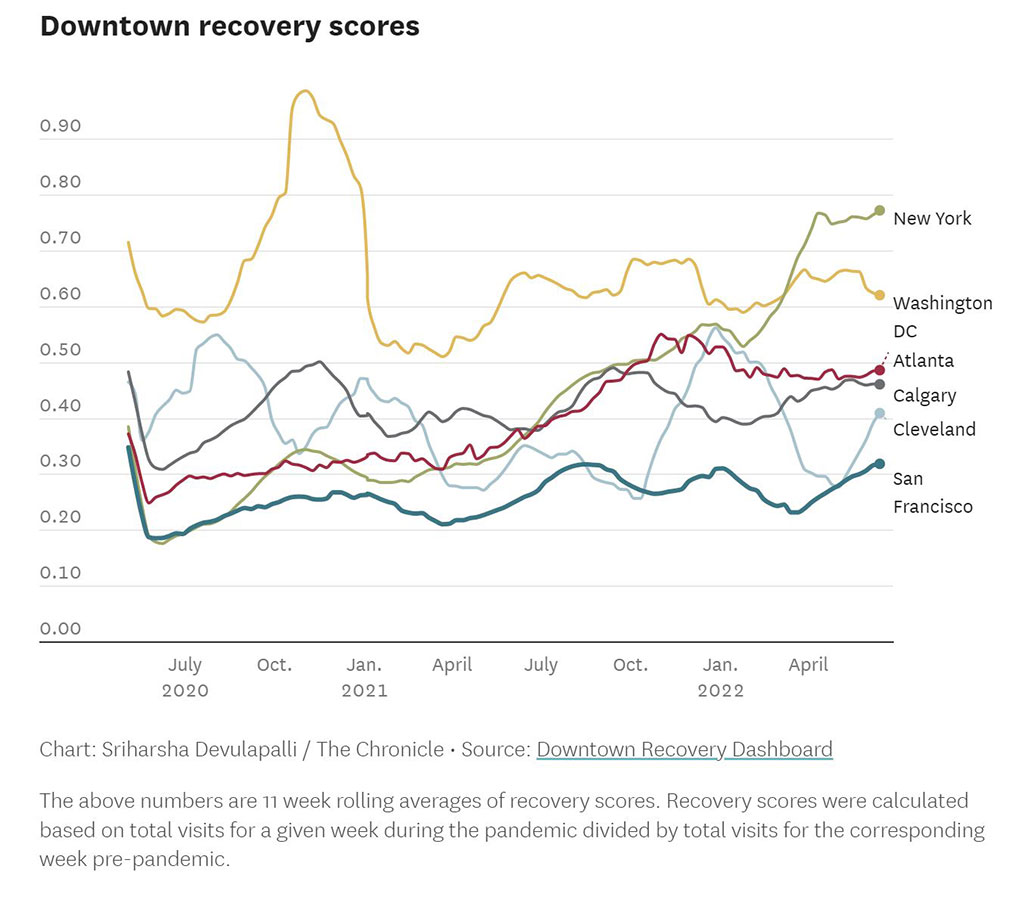
San Francisco has been disproportionately impacted by the “work from anywhere” model, leaving the city with empty office buildings, an underutilized downtown, and a compromised city budget. More than half of all Bay Area workers have computer-based jobs concentrated in professional service firms, technology companies, and industries embracing remote work. New data released from the U.S. Census Bureau’s American Community Survey shows that 46% of San Franciscans (aged 16+) worked from home in 2021, compared to 7% in 2019.
Downtown San Francisco is not alone in its compromised recovery. It’s something that is occurring in financial cores across the U.S. but is more pronounced here due to our unique workforce population. What’s happening to San Francisco could be a bellwether for what’s to come for other major cities.
We can’t afford a vacant downtown.
For city centers built around a single office use, like downtown San Francisco, the impacts of vacancy have been widely felt. Empty buildings mean fewer people on the streets, which hurts small local retail businesses and fosters crime and vandalism.
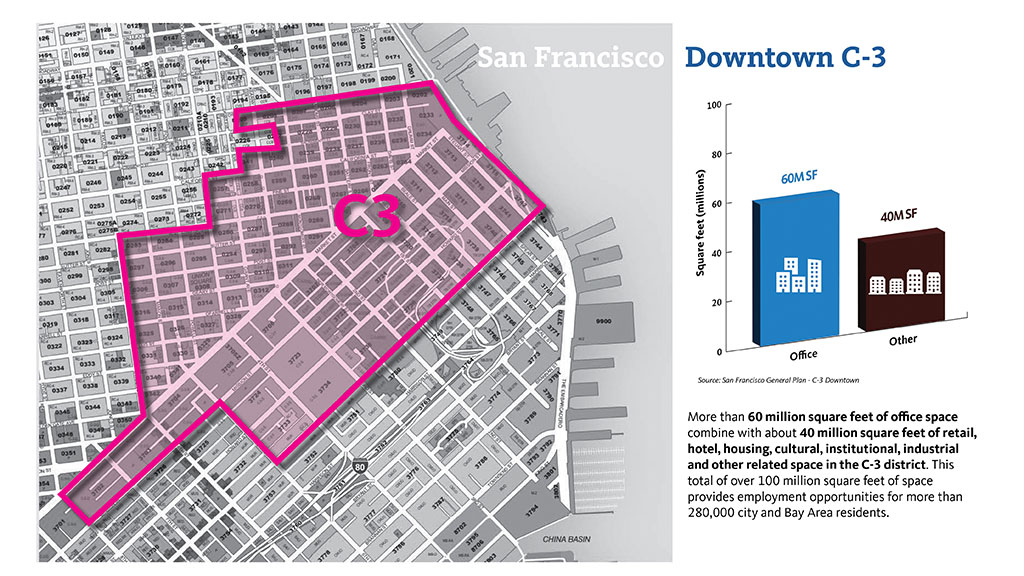
To make matters worse, downtown buildings make up a disproportionate share of the city’s tax-base because of their size and density, which include both property taxes and business taxes. Without these buildings being occupied by tenants, city funding will decline, which directly impacts the ability to deliver social services, improve schools, and provide law enforcement and public services. In a recent CNBC interview, San Francisco Mayor London Breed quoted a city budget deficit of more than $700 million, which she links to empty offices and struggling downtown businesses. An empty downtown is every San Franciscan’s problem, with larger ripple effects across the Bay Area Region.
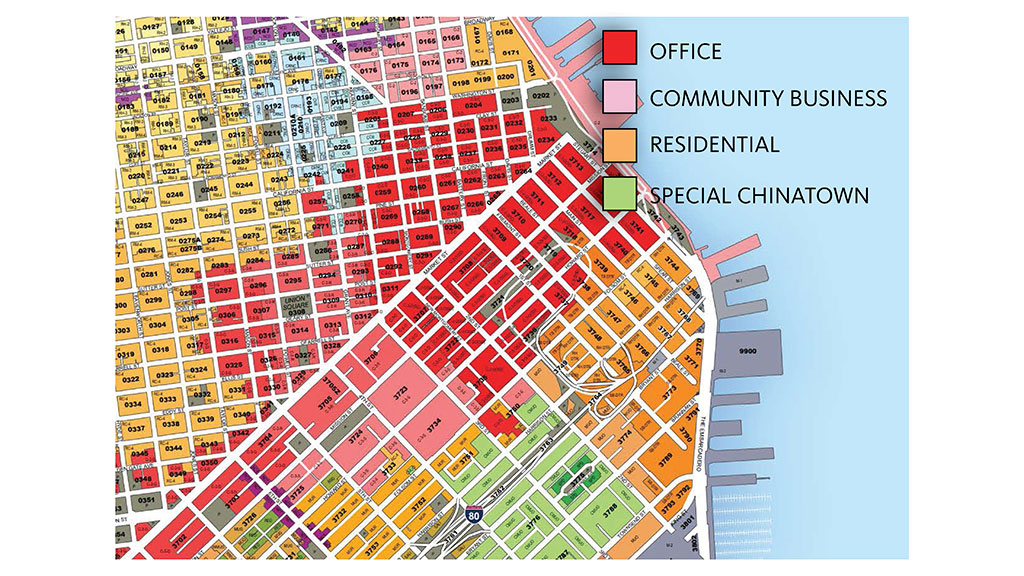
A CBD primarily used for office is no longer viable or sustainable.
One of the biggest challenges for San Francisco is in its planning. Downtown (the Financial District) is almost exclusively used for office. The city center is filled with office buildings that are only occupied during work hours, leaving them empty the remaining hours and days of the week. The pandemic exacerbated this problem, putting a spotlight on the problems of a mono-use district, such as a centralized business district with only 9-5 use. Frankly, it was never a great idea, and now is no longer viable or sustainable.
Now is the time to reimagine downtowns by changing these single-use districts to better adapt to continuous change and uncertainty, which is gradually becoming the “new normal.” To stay agile and still thrive, we must diversify the mix of uses in our downtown developments. We cannot revive San Francisco’s urban core with new street furniture or an occasional live music concert. Those are great interventions, but they conceal the core problem: a lack of diversity of uses to keep CBDs activated 24/7, rather than just 9-5.
Downtown isn’t dying, it’s evolving.
Cities have always evolved and changed with the times. Most major cities have survived seminal events, such as hurricanes, floods, and even wars. Perhaps best known for enduring earthquakes and fires, San Francisco has always thrived on change, from the Gold Rush to the tech revolution. Radical change is in its DNA. Historically, mixed-use communities have always been a vital part of every city, where residences comingled with retail offerings, artisans, and industry. It wasn’t until the Industrial Revolution and the introduction of steel framing, elevator technology, and zoning codes that downtowns evolved from mixed-use neighborhoods into the office districts/CBD that is more familiar to us today.
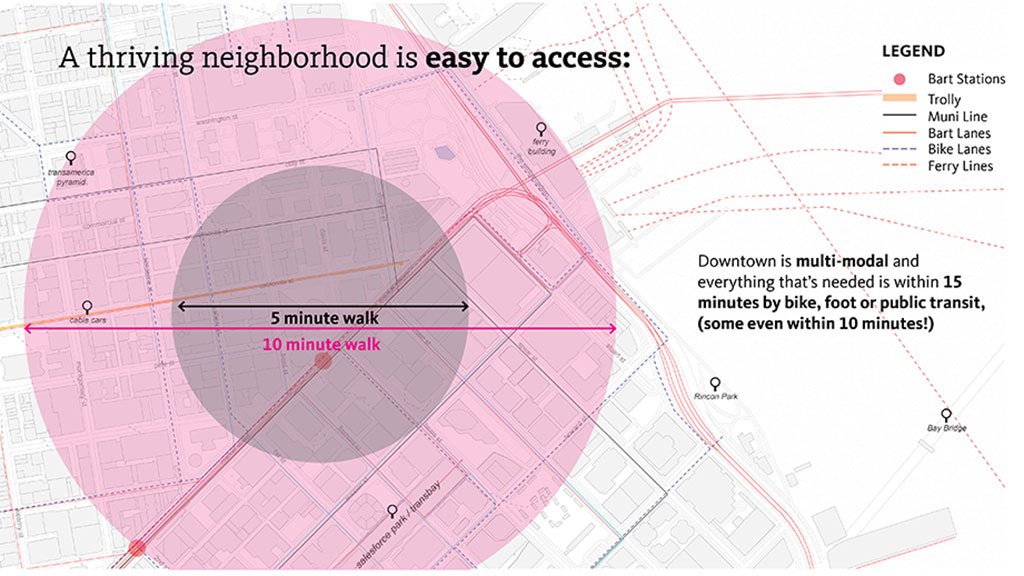
It’s time to reimagine our downtown as a neighborhood that accommodates not just work but also has opportunities to live, play, and learn. The most successful urban neighborhoods have a unique character and offer various experiences where everything is available within 20 minutes by bike, foot, or public transit.
As a distinct neighborhood, downtown San Francisco is unique in that it is one of the only neighborhoods that integrates, work, commerce, and residential developments with the water. Much of the expensive infrastructure needed for success is already baked into downtown San Francisco. With access to public transit, open spaces, Privately Owned Public Open Spaces (POPOS), parks, and museums, the area is one of the city’s most connected neighborhoods and cultural hubs. What’s missing is an adequate diversity of uses to balance out the ecosystem.
A healthy downtown is a mixed-use downtown.
We reimagine downtown as a vibrant neighborhood. Instead of an office-focused central business district, picture an experiential community that offers a healthy mix of offerings: office, schools, shopping, restaurants, and most importantly: housing for all. It’s a neighborhood that’s easy to navigate and diverse in its offerings, with a range of building types, ages, and affordability.
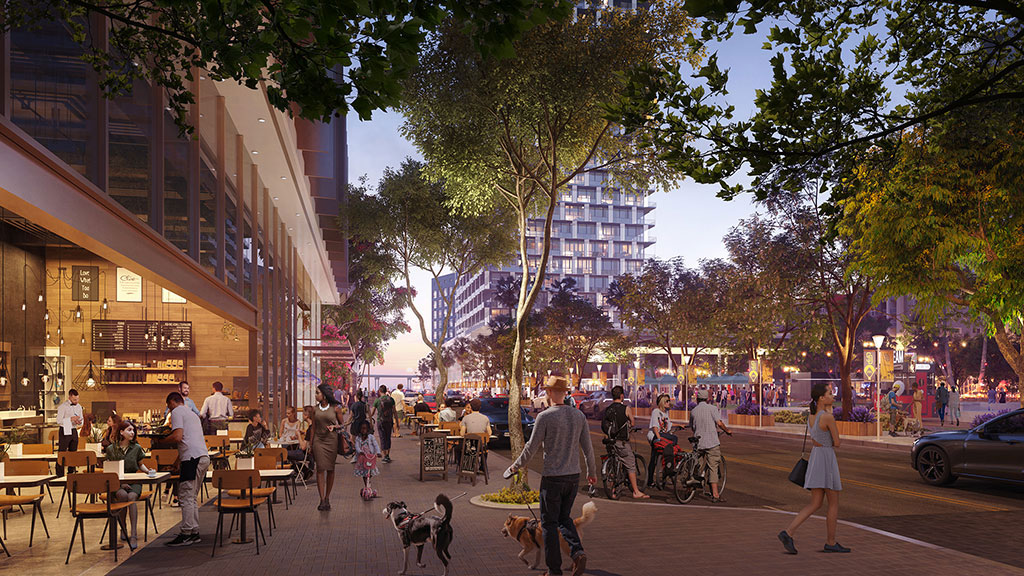
A 2022 city survey conducted by Gensler shows that most people are open to moving downtown if it were affordable, safe, and had an activated neighborhood feel. Gensler’s City Pulse Survey finds that people identify restaurants, social venues, and cafés as the most important features of a great city, followed by parks and open spaces, access to transit, shopping, theaters, museums, and other cultural attractions. Commercial and office uses were ranked last.
Why mixed-use matters to reviving downtown.
A mixed-use neighborhood means a diversity of users and activities. It also means the spaces are activated at all times of day, and all days of the week. More eyes on the streets means more security and less crime or vandalism. With more planning and intention, the sidewalks, alleys, and surfaces throughout downtown can host a range of events, activities, and creative expressions, such as installations or performances.
Downtown SF Partnership recently put forward strong solutions around how to leverage and improve upon the ground plane of our city with both physical and programmatic design solutions. Taking these ideas forward, we envision giving more of our streets back to the people and transforming the non-commute arterial streets, which are less traveled (such as Main St, Steuart St, or Halleck Alley), into slow streets. These streets, which are nearest the bay, have less vehicular traffic and could be enhanced to create quieter, safer bike and pedestrian paradises where outdoor restaurants and communal activities could thrive. But public realm changes like these won’t accomplish it on their own.
The most sustainable city is the one that’s already built.
In order to achieve diversity and density in our downtown we need one critical thing: more attainable places to live. The most expeditious path is to convert our office buildings into multi-family housing. By reusing the existing downtown building stock, we not only create a more balanced ecosystem but also do so in a way that is more sustainable for the planet.
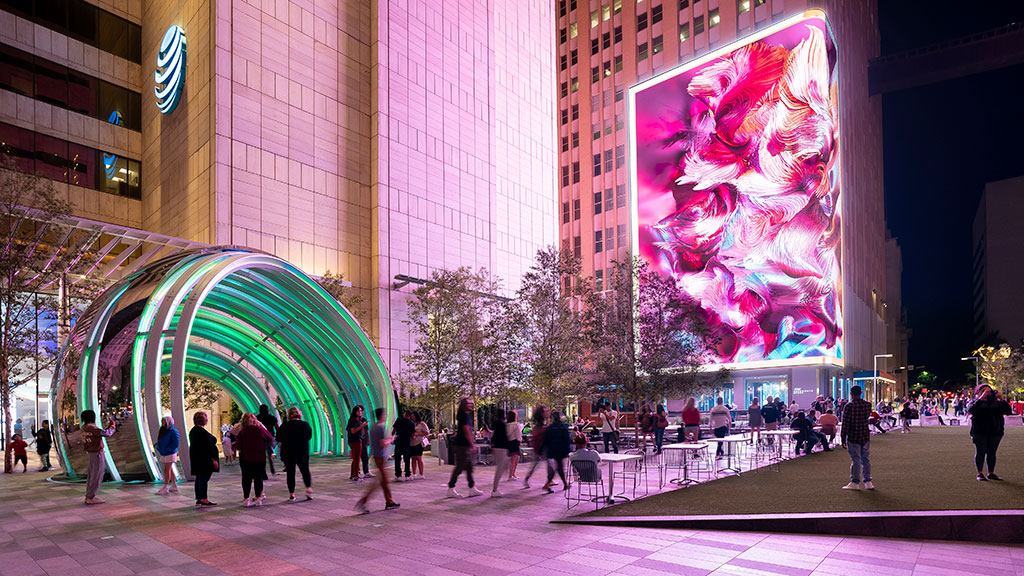
Recycling buildings through adaptive reuse is environmentally positive, can save 90% of a building’s materials while respecting the character and history of the site, and preserve the connective tissue of the city. Construction contributes to 11% of global carbon emissions, according to Architecture 2030, and adaptive reuse can cut that by up to 80%. Given this outsized impact, reusing our buildings affects the triple bottom line — people, planet, and profit.

The next big questions are how to do it, what’s in our way, and what must change to bring diversity back to our downtowns and to, once again, make them neighborhoods for people to thrive in.
In part 2 of our blog series, we will investigate these questions.
For media inquiries, email .



